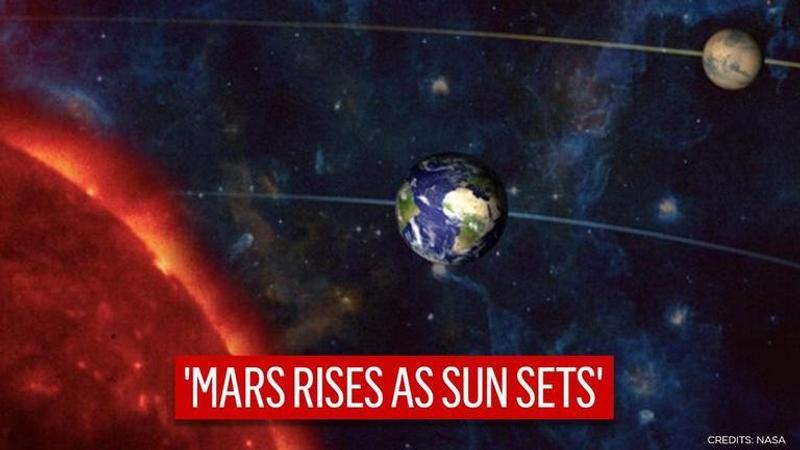Published 19:35 IST, October 13th 2020
Mars to shine brightest tonight during October opposition, here's how to spot red planet
NASA updated skywatchers to get ready to witness Mars outshining everything else in its region of sky in a unique night never seen until September 2035.

In an extraordinary phenomenon known as ‘opposition’, the red planet Mars on October 13 will appear the brightest at its perihelion and will dim out for the next 25 years until 2035. According to NASA, the red planet will rise in the east of the Earth, appearing to be extra bigger and brighter just as the sun sets in the west in a rare occurrence that happens once in 15 or 17 years. Tonight, the red planet is closest to the sun due to "perihelic opposition” as skywatchers can witness the red planet’s straight-line alignment due to its perfectly stable orbits with planet Earth perched right in the middle.
In an official release, NASA updated the skywatchers to get ready to witness the red planet to outshine everything else in its region of the sky in an amazing, unique night never seen again until September 2035. “Mars is currently visible, reaching its highest point in the sky around midnight. Earth’s closest neighbor is also at its brightest and will remain that way well into November,” it informed the astrophiles.
How to watch?
In the interim, skywatchers can use any telescope that can show Mars' ruddy disk, including its surface features. Advanced software applications like Starry Night 8, a Professional Astronomy Telescope Control Software can be used to detect the Red planet's position, at a variation of about 20 percent, between 128.4 and 154.8 million miles (or 206.7 and 249.2 million kilometers) from the Sun's direction. Further, if one looks to the east with the human naked eye, they can see a big, bright “star” that’s slightly reddish well positioned for anyone in the northern hemisphere.
[During opposition, Mars and the sun are on directly opposite sides of Earth. From our perspective on our spinning world, Mars rises in the east just as the sun sets in the west. Credit: NASA]
While usually, it’s the planet Jupiter that makes the third celestial object after Venus and Moon to be the brightest, this year 2020, Mars outshines Jupiter, NASA said. Further, citing ‘Opposition’ as the reason for the planet’s close alignment to Earth, NASA explained, “opposition occurs when the orbit of a planet, such as Mars, takes it near the Earth”. The space agency added, “just like runners passing each other on a track, the faster, inner planets, such as Earth, can approach and overtake slower-moving outer planets like Mars.”
Sun, Earth, Mars on' narrowest' alignment
Tonight, Mars will be at an estimated distance of 40 million miles (60 million km) as opposed to its usual 250 million miles (400 million km) distance. “Nearly seven times closer,” NASA informed. The Earth, Sun, and planet Mars will be in a straight line at 23:20 GMT (00:20 BST) with a separation of 62,069,570km, or 38,568,243 miles, the narrowest gap until 2035, as only last week, Mars entered into the closest approach in a 26-month cycle with Earth. Astrophotographer, Damian Peach told sources of BBC that one did not have to linger on to any specific timings, scubas 9 pm or 10 or the midnight, as sunsets in the west, the viewers can't miss the brightest star-like object in the sky, Mars.
[Two illustrations contrasting Mars’ position when it reaches opposition and conjunction. During opposition, like in October 2020, Earth passes near Mars – which is easily visible and bright. During conjunction, Mars and Earth are far from each other, so Mars appears small and faint. Credit: NASA]
Updated 19:34 IST, October 13th 2020





